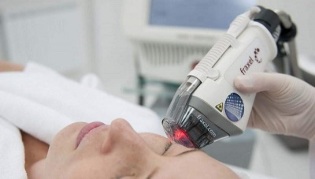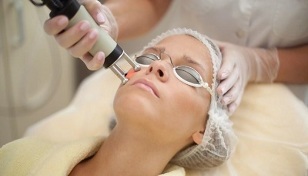
The main cause of skin aging is a deterioration in the functional capacity of metabolism and cell growth, as well as a slowdown in the removal of toxins and toxins and a decrease in the nutrient supply to cellular structures. Thanks to laboratory tests, it has become known that this is a reversible process, i. e. there is always the possibility of activating cell activity. Scientists have found that after thermal exposure to the laser, part of the cells in the dermis are activated and the other dies. Usually, dead cells die, not living cells that are unable to recover further.
During the process of weak cell death, the void intercellular space is occupied by stronger cells. The heat effect after the laser treatment activates the cell activity, continues the renewal and growth of the cells. The quality and speed of the cell system depends on the diameter of the laser beam. Thickness should not exceed 200 microns, then healthy and young skin layer begins to form in the treated area.
For this reason, the laser rejuvenation technique has been further developed with the introduction of fractional thermolysis. In this process, the laser beam is divided into many microscopic beams, thus creating a network of the area of action in the treatment area. The innovative value of the technology lies in the fact that the laser works in local areas, which preserves intact skin surfaces - accelerating skin regeneration and healing.
Variants of fractional thermolysis
Fractional laser rejuvenation has been successfully used to tighten and tighten skin using one of two possible methods. They differ in the characteristics of laser operation, the depth of penetration, and its effect on certain areas.

The first method of action - fractional photothermolysis - affects the upper epithelial cells, literally evaporating them. In other words, with this method, only the upper skin layer is exposed.
The second method of treatment involves the lower epidermis and the skin layer, leaving the upper layer of the skin intact. In both cases, the laser beam has a local effect. A cellular programming zone remains around the treated areas, creating the potential for further skin regeneration. In other words, heat shock activates new cell growth and metabolic processes in the cells.
The first method of fractional photothermolysis removes the superficial microscopic areas of skin cells, squeezing the treated areas in a short time, so that the results after the procedure are immediately noticeable. It smoothes out surface wrinkles and is therefore ideal for eliminating the first signs of age-related skin changes.
The second method of laser influencing is to solve problems deep in the skin when the aging process is already irreversible. This method is a kind of "heavy artillery" of laser rejuvenation. By acting on the deep layers of the epidermis and dermis, the laser initiates metabolic processes, creates a new membrane frame, activates collagen production, making the skin younger and regenerating from the inside.
It has been shown that the maximum efficiency of fractional photothermolysis is achieved by the combined use of two exposure methods. In this case, the skin gets a double effect - both inside and out, which ensures the effect of skin rejuvenation in the long run. A similar technique is used in many modern medical institutions that have modern laser equipment at their disposal.
Efficiency of the procedure
You can ensure that your skin is smooth, smooth and radiant after the first procedure after fractional laser rejuvenation. Within a week, the oval of the face tightens noticeably, the wrinkles smooth out, and the face evens out. In order to consolidate and extend the result, a procedure will be required at monthly intervals.
With combined fractional rejuvenation, the effect of youthful skin can be achieved much faster and lasts for up to 2-3 years. Of course, the results depend a lot on the lifestyle of each patient. Giving up bad habits, preventative facial care, a healthy lifestyle, proper and proper sleep will help prolong the youthfulness of the skin and prevent the aging and fading process.
The undoubted advantage of the procedure is pain relief. The specialist uses surface anesthesia, so the patient feels only a slight tingling in the affected area during the procedure.
Progress of the procedure

The undoubted advantage of the procedure is pain relief. The specialist uses surface anesthesia, so during the procedure, the patient feels only a slight tingling in the affected area. The anesthetic is applied shortly before the start of the session, which can last up to an hour, depending on the surface of the treatment.
After the procedure, the specialist will advise the client on the necessary skin care, treat it with special medications.
Immediately after the procedure, the skin does not need further care. It takes a little over a week to return to a normal rhythm of life, while postoperative rehabilitation is much more difficult and takes longer.
For the first two days, the face will be swollen, then turn slightly red. After 4-7 days, the dead cells begin to clear, revealing fresh and youthful skin.
Procedure indications
If in doubt about the effectiveness of fractional laser rejuvenation, you may want to visit the procedure from the beginning according to the indications, many of which are:
- Acne.
- Pigmentation.
- Spider veins, stretch marks and scars.
- Enlarged pores.
- Wrinkles, crow's feet around the eyes.
- Weak, wilting and loose skin.
Contraindications to the procedure
As with all salon treatments, fractional rejuvenation has several contraindications:
- Benign and malignant tumors in the treatment area.
- Cancer and ongoing chemotherapy
- Dermatoses and photodermatoses in the field of the procedure.
- Herpes infection within a month.
- Acute infectious infections, immunodeficiency.
- Chronic diseases such as bleeding disorders, diabetes mellitus, thromboembolic diseases.
- Psoriasis and high blood pressure.
- History of keloid scars or vitiligo, family history of vitiligo or keloids.
- Fresh tanning, last tanning visit.
- Pregnancy and breast-feeding.
- Use of retinoids in the last six months.
Combination of fractional rejuvenation with other processes
This procedure is always performed only after prior consultation with a beautician. With pronounced age-related changes, laser skin rejuvenation results in maximum efficiency, not a method of fractional rejuvenation.
In some cases, this cannot be done without surgical manipulations, namely endoscopic facelift, blepharoplasty, or insertion of fibers to tighten. Nevertheless, laser rejuvenation helps maintain and increase the efficiency of procedures. This complements their results and refines the look of the customer.
Laser rejuvenation techniques are perfectly combined with procedures such as mesotherapy and plasma lifting, as well as hyaluronic acid-based biorevitalization.






































